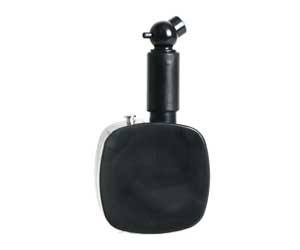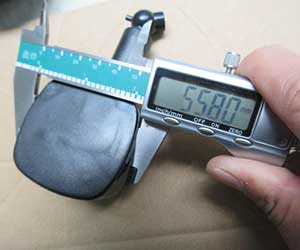Automobile Tyre Meter
Specification
-Material: ABS
-Dia of the dial: 45MM
-Color: Black
-Measure range: 0.2-4.5BARS
-Package: black plastic case
-Item size:10.5*5.2CM
-Packing case size: 14.5*6.3CM
Features
-Shockproof cover for high precision.
-Suitable for all kinds of pneumatic tire internal pressure detection of vehicles.
-The extended tube is flexible and not easy to break off
-Durable, compact, practical, easy to carry, and easy to operation
-Portable, lightweight, and easy to take along cars.
-360 degrees rotation, easy to adjust the angle.
-High-quality precision movement, high precision measurement, and durability.
Use steps
1. Remove the tire valve cap.
2. Tighten the copper head of the tire pressure gauge into the valve.
3. The tire pressure gauge will display the pressure in the tire.
4. Please add gas if the tire pressure is insufficient. Press the bleed valve if the tire pressure is too high.
5. To zero the pointer, unscrew the copper head and press the bleed valve. The original tire valve cover should screw back.
Why need a dial tire pressure gauge?
Make sure your car is running at its best it needs some tender loving care, which means checking tire pressures regularly.
Safety first: driving your family and friends or traveling by car is a great responsibility. Your vehicle must be in top condition to protect your passengers. Properly inflated tires are safer and less prone to failure at high speeds. A car tire gauge pressure is an essential tool for any driver. It helps to ensure that your tires’ air pressure is always at the right level and you don’t risk puncture or blowouts. It mustn’t be just about the safety of your tires but also the safety of other drivers on the road.
Save gas money and the environment: When tires are not correctly inflating, they are less “round” and require more energy to get moving and maintain speed. Additionally, underinflated tires contribute to pollution and increase fuel costs. So get a dial tire gauge to save money and mother nature. A recommended pressure enhances performance, ride comfort, service life, and fuel efficiency.
Best performance: Psi is the pound-per-square-inch measurement (PSI). For the best performance, tires should inflate to the correct pressure. A car tire gauge can help you determine the right pressure.
To ensure that your tires are inflating at the perfect pressure, you need to use a car tire gauge pressure.
Are tire pressure gauges accurate?
Additionally, it’s accurate – it seals over the valve, so you get an accurate reading (up to 6.5 or 100, respectively).
How to check and adjust tire pressure?
It only takes a few minutes to check the tire pressure on your car. Here’s a step-by-step guide:
1. Use a good, well-maintained car tire pressure gauge.
2. Check your car’s recommended pressure setting.
3. Before the car drive more than a couple of miles, check the tire pressure when the tires are cold: after they have sat for at least three hours. As tires heat up, air pressure increases, making it difficult to measure changes in pressure accurately.
4. To check each tire, remove the screw-off cap from its inflation valve first.
5. Depress the valve end of the tire pressure gauge. You should push the gauge further if you hear air escaping from the valve.
6. Make sure the spare tire is properly inflating.
How do I choose an automobile tire meter?
PSI Range: Select a tire gauge that works within the tire’s pressure range. If your tires are 30 psi, you should get a 60 psi gauge. Get a 30 psi gauge if you run 15 psi.
It’s vital to your safety to keep your car tires properly inflated. Under-inflated tires generate excess heat as they drive, which can lead to tire failure. Also, underinflated tires wear faster and unevenly, waste fuel, and negatively affect braking and handling. Keep your tires in top condition by checking their pressure monthly and before any long trips. Check the tire pressure after the car park for three hours or more.
What do you know about this 4.5 bar tire pressure gauge?
Many tire-pressure gauges are available at auto-parts stores, big-box stores, and online retailers. Ensure the tire pressure gauge’s accuracy and longevity by keeping it in a protective sleeve. You should replace an old, worn, dirty, or dropped gauge if it is no longer reliable. You should replace an old, dull, dirty, or dropped meter if it is no longer reliable.
Types
The three types of tire-pressure gauges are stick, digital, and dial.
Stick-Type
Stick gauges are simpler, compact, and more affordable than most digital ones.
Digital
As with a pocket calculator, digital gauges have an LCD that makes them easier to read. Additionally, dust and dirt are less likely to damage them. When checking the pressure in low light, some digital readouts light up.
Dial
In dial gauges, the pressure indicates by a simple needle on an analog dial, similar to a clock face. Although dial gauges have more features than pocket-sized gauges, such as an extension hose, bleeder valve, and dual-scale dial, they are sometimes more accurate. Dial gauges are usually easy to read.
















